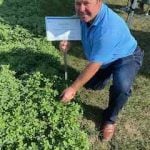ST. PAUL, Alta. – Farmers are well known for their preference for working independently, but partnerships may be better when producing herbs and spices.
“I don’t think it’s common now but I think it will be a new venture,” said Alberta Agriculture rural development specialist Morley Kjargaard at a crop diversification workshop.
Plenty of herb and spice buyers want to buy large quantities of the product, but one to three acres of the speciality crops like St. John’s Wort and echinacea are typically all producers can manage.
Read Also

Agriculture ministers commit to enhancing competitiveness
Canadian ag ministers said they want to ensure farmers, ranchers and processors are competitive through ongoing regulatory reform and business risk management programs that work.
“After that the product starts to suffer,” said Kjargaard, who noted most buyers he has called want 1,000 to 5,000 pounds of product at a time.
The challenge of supplying to larger markets is one reason Saskatchewan Herb and Spice Association members hope to form a marketing partnership within the next two years, according to president Martin Gareau.
“You’d be hard pressed to find buyers who will take 500 pounds,” he said.
For the past 10 years the association has been involved in education and promotion and now wants to evolve into marketing.
The group could find contracts for herbs and spices and act as a collection agency for buyers, said Gareau. This would give producers a better chance to attract large-scale buyers who want quantity assurance and prefer to deal with one contact.
Another option for the group is to get into processing for buyers who prefer a grounded or sifted product, added Gareau, who doesn’t know where the business would be based.
About 40 people are interested in the project so far, but Gareau expects others to follow.
“I think the sky is the limit,” he said.
Focus on production
With business members hunting for contracts and researching good prices, producers could concentrate on growing high quality crops, added Gareau.
“The grower could focus on what they do best. It takes more care to produce value herbs than wheat.”
The largest challenges the group will likely face include guaranteeing quality and consistency, said Gareau, noting not all producers follow the same practices.
Shelley Bradshaw of Innisfail Growers said the partnership she and her husband have with four neighboring couples works well. Although the group focuses on vegetables, Bradshaw provided partnership tips at the March 8 meeting.
One advantage it offers is more time to market effectively, she told the audience.
“When you’re scrambling to keep up, you don’t have time to do any of the extras.”
With more people in the group, the company participates in 22 farmers markets a week to give wide exposure to products. Between the families a wide array of vegetables is grown, which helps attract customers, she added.
As well, the group shares costs like maintaining a central facility and advertising.
One of the disadvantages is the need to compromise, she said, adding one always has to concentrate on doing what’s best for the company.
One of the important factors for success in any partnership is good communication, including regular meetings, said Bradshaw. Those involved must have common goals and a desire to be actively involved.
Good records are essential, as are well-defined responsibilities for group members, said Bradshaw.














